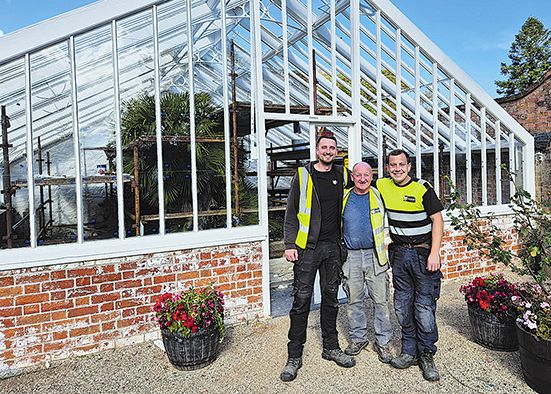£5m improvement work continues in forest park
£5m improvement work continues in forest park
22 October 2025

WORK is continuing at pace on a £5m investment programme at Castlewellan Forest Park.
The major upgrade is designed to make the highly acclaimed park — which stretches to over 1,100 acres — one of the best in Ireland and will overhaul a range of existing facilities and provide a number of exciting new developments.
Funding is being provided by The National Lottery Heritage Fund and Newry, Mourne and Down Council with the restoration work entering its final chapter.
Local authority officials say given the age of the buildings involved in the multi-million pound project, the restoration work has been a long and painstaking process, but the end is in sight.
The last of the terrace glasshouses — the Rock House — has now been fully restored, with the final panes of glass added.
Restoring the glasshouses has been a painstaking process, but they now resemble their former glory and are at the heart of the project to conserve the forest park’s rich, natural and built heritage.
Elsewhere, the restoration work celebrates the internationally important Annesley Walled Garden and Arboretum, protects and enhances biodiversity and is restoring the Grange to become a vibrant visitor and community hub.
The Walled Garden was currently closed for major refurbishment works, in particular, to facilitate not only the restoration of the green houses, but essential drainage work, restoration of the cobble path sidings and the fountains.
Since the 1740s, the sprawling forest park was the demesne of the Annesley family, who created a beautiful landscape and a nationally and internationally important 45-hectare arboretum.
The redevelopment project aims to create a new vision for the historic Castlewellan demesne, delivering what is being described as a “heritage-led destination” to connect people with their built and natural heritage.
Council officials and local politicians are keen to see the Arboretum, Annesley Garden and Grange Buildings redeveloped to help increase the number of visitors and provide the area with an economic boost.
Officials say the focus was on improving amenities and the interpretation of the park’s natural and built heritage.
The local authority holds a 20-year operating licence for the park’s walking, bike and horse riding trails, in addition to play facilities, with formal links established with a number of organisations in relation to the future management of the park’s Bothy Yard, glasshouses and propagation in particular.
The ‘Re-Rooting our past in the Future: Castlewellan Historic Demesne’ project is designed to revitalise and conserve the cultural and natural heritage of the park for present and future generations.
Those supporting the project say it is committed to the “sensitive conservation and management of the landscape,” ensuring the protection of its plant collection and vital biodiversity, with the National Arboretum and Annesley Garden at the heart of the forest park.
In tandem with the redevelopment work, head gardener Alwyn Sinnamon and his team have been at the heart of repairing the catastrophic damage caused by Storm Éowyn last January when over 1,000 trees were felled.
The storm obliterated sections of the hugely popular mountain bike trails which were left unrecognisable, with award winning and internationally recognised trees planted over a century and a half ago brought crashing to the ground as the devastatingly destructive storm mercilessly bludgeoned its way through parkland.
The historic Walled Garden bore the brunt of the storm with up to 50 trees in this area alone snapped like twigs, with internationally recognised and revered trees literally ripped from the ground.
Castlewellan Forest Park is unique in global terms and in its heyday was the top garden to come and see conifers of the world. In 2018, members of the International Dendrology Society paid a visit and were left overwhelmed by the many species they encountered.


